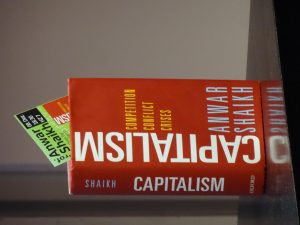Socialism and the White House
✑ MICHAEL ROBERTS | ± 10 minutes
The Trump White House research team has issued a very strange report, purporting to prove that ‘socialism’ and ‘socialist’ policies would be damaging to Americans.
‟Of course, this is all smoke and mirrors.
The Trump White House research team has issued a very strange report, purporting to prove that ‘socialism’ and ‘socialist’ policies would be damaging to Americans.
Originally published by The Next Recession (Oct 27, 2018).
|
|---|
About the author (click)
Michael Roberts, a marxian economist and author, works in the City of London as an economist and has written extensively on economic crises from a marxian perspective. He has published several books including his most recent The Long Depression; Marxism and the Global Crisis of Capitalism (2016) published by Haymarket Books. In recent years, his blog The Next Recession has reached an international audience.
T

he Trump White House research team has issued a very strange report. It’s called “The Opportunity Costs of Socialism,”. It purports to prove that ‘socialism’ and ‘socialist’ policies would be damaging to Americans because the ‘opportunity costs’ of socialism compared to capitalism are so much higher.
What is strange and rather amusing is that the White House advisers to Trump deem it necessary to explain to Americans the failures of ‘socialism’ in 2018. But when you delve into the report, it becomes clear that what is worrying the Trumpists is not ‘socialism’, but the policies of left Democrat Bernie Sanders for higher taxes on the rich 1% and the increased popularity of a ‘single-payer’ national health service for all. The popularity of these policies threatens the Republican majority in Congress and also the wealth and income of big pharma corporations and Trump’s billionaire supporters.
What the White House means by socialism is apparently a national economy that is dominated and controlled by the state rather than the market. “Whether a country or industry is socialist is a question of the degree to which (a) the means of production, distribution, and exchange are owned or regulated by the state; and (b) the state uses its control to distribute the economic output without regard for final consumers’ willingness to pay or exchange (i.e., giving resources away “for free”).”
So the report has a wide and all-encompassing definition of ‘socialism’ that includes Maoist China (but not modern China it seems), the Soviet Union, Cuba and Venezuela and the Nordic ‘social democratic’ states. The latter are bunched together with the former because Sanders lauds the latter and not the former. Naturally this raises the question of whether any of these countries can be called ‘socialist’ ie a peasant-dominated Soviet Union in 1920 or China in 1950; or the family-owned corporate dominated economies of Sweden, Denmark and Norway.
The White House definition is not socialism or communism as proclaimed by Marx and Engels in the Communist Manifesto. For them, Communism is a super-abundant society with no role for a state but only for the free association of individuals in common action and ownership of the products of labour. Of course, such a world system does not exist and so cannot be compared with capitalism. Instead, in effect, the White House is really trying to compare a planned national economy with a capitalist-dominated national market economy. But we should not be too harsh on the White House researchers: they are not going to know what socialism is; and their definition (that they got from the dictionary, apparently) is probably most people’s view.
Leaving that aside, what is wrong with all these ‘socialist’ states? Well, “they provide little material incentive for production and innovation and, by distributing goods and services for free, prevent prices from revealing economically important information about costs and consumer needs and wants.” In Maoist China and Stalinist Russia “their non-democratic governments seized control of farming, promising to make food more abundant. The result was substantially less food production and tens of millions of deaths by starvation.” Thus socialism was a disaster.
From their definition, the White House report concludes: “The historical evidence suggests that the socialist program for the U.S. would make shortages, or otherwise degrade quality, of whatever product or service is put under a public monopoly. The pace of innovation would slow, and living standards generally would be lower. These are the opportunity costs of socialism from a modern American perspective.”
The White House report also claims that “replacing U.S. policies with highly socialist policies, such as Venezuela’s, would reduce real GDP at least 40 percent in the long run, or about $24,000 per year for the average person.” And replacing the current US tax regime with that of the Nordic countries would increase the tax burden on Americans by $2,000 to $5,000 more per year net of transfers. “We estimate that if the United States were to adopt these policies, its real GDP would decline by at least 19 percent in the long run, or about $11,000 per year for the average person.”
‟A most hilarious case study is presented for this claim: the cost of buying a pick-up truck in Texas compared to the cost in Scandinavia!
The first argument of the White House report is that living standards are higher in the US compared to the ‘socialist’ Nordic states. A most hilarious case study is presented for this claim: the cost of buying a pick-up truck in Texas compared to the cost in Scandinavia!
Well, a pick-up truck may be much more useful in Texas than Stockholm and, given that taxes on vehicles are lower in the US and fuel taxes are substantially lower, the argument that a pick-up truck costs much less than in the Nordic countries is irrefutable! But does the more expensive truck in Norway compared to Texas prove that there is a higher ‘opportunity cost’ of living in ‘socialist’ Norway? What about public transport, public services, health and education, unemployment and welfare benefits – things that the richer part of any capitalist country does not need or use as a ‘social wage’? These things are not compared by the White House report.
The report points out that real GDP per capita is higher in the US than in the Scandinavian economies and in the non-oil part of Norway. The data show this is true. But all this shows is that Northern Europe started at a lower level when Marx wrote the Communist Manifesto. Actually, if we look at real GDP growth per capita since 1960 (when Americans are told that they live in the greatest place on earth), US growth has fallen behind the most Nordic economies and for that matter, most European economies. Indeed, since the early 1990s, real GDP per capita growth has been faster in Sweden than in the US.
And as for China, the growth rate has outstripped that of the US many times over since the 1990s, taking 800m people out of World Bank defined poverty. No doubt the White House researchers would argue (although they don’t) that China turned ‘capitalist’ in the 1980s and this is why the economy has rocketed. But this would be inconsistent with their view that a ‘socialist’ state is one where the state dominates and controls the free market economy. For China must be the most state-directed major economy in the world, way more that the so-called ‘mixed economies’ of the Nordic countries.
Overall income is one thing but the distribution of that income is another. Here the White House has to admit that “though the Nordic economies exhibit lower output and consumption per capita, they also exhibit lower levels of relative income inequality as conventionally measured.” What is interesting here is that the US still has much higher inequality of wealth and income, but Nordic inequality has also risen much in the last 30 years as governments there adopted pro-business polices of reducing corporation and personal taxes (ie pro-market policies).
Indeed, as the White House report says, on some measures, the Nordic tax system is more accommodating to the top 10% than the US system – at least for personal tax: “Lower personal income tax progressivity in the Nordic countries, combined with lower taxation on capital and on average only modestly higher marginal personal income tax rates on the right tail of the income distribution, means that a core feature of the Nordic tax model is higher tax rates on average and near-average income workers and their families. That is, contrary to the misperceptions of American proponents of Nordic-style democratic socialism, the Nordic model of taxation relies heavily not on imposing punitive rates on high-income households but rather on imposing high rates on households in the middle of the income distribution.”
‟This may be an attack on Sanders’ praise for the Nordic economies, but it seems to me that it proves how far away the Nordic states are now from ‘social democracy’, let alone ‘socialism’.
This may be an attack on Sanders’ praise for the Nordic economies, but it seems to me that it proves how far away the Nordic states are now from ‘social democracy’, let alone ‘socialism’. On the one hand, the White House report claims that ‘socialist’ states want to tax the rich harder (a la Sanders) but in reality they tax them less hard than in the US!
Of course, this is all smoke and mirrors. All the data on inequality of wealth and income in the major advanced economies show that the US is the most unequal, both before and after tax; and that real disposable incomes for the average American family have hardly risen in 30 years while the top 1% have seen substantial rises.
The share of wealth held by the top 1% of earners in the US doubled from 10% to 20% between 1980 and 2016, while the bottom 50% fell from 20% to 13% in the same period.
But the main part of the White House report is to argue that privately-funded education and healthcare is more cost-effective than publicly-funded state schools or a national health service. The report argues that paying for a US college education will bring a much bigger return in future earnings than it will in Norway, where there are no college fees. What this implies, however, is that people in the US without higher education qualifications have no chance of earning decent incomes, while those without degrees in Norway do not earn much less than those that do! So actually the opportunity cost of not having a college education in Norway is much lower.
Then there is healthcare. According to the White House, ‘single payer’ health systems, as applied in nearly all advanced economies, are not as efficient and beneficial to health as America’s free market insurance company schemes, especially if Obama-care is excluded. The proof? Well, old people in the US have to wait less time to be seen by a specialist than in single-payer systems, says the report.
Actually, American ‘seniors’ mostly receive Medicare, so they are on a single payer scheme when they get to see a specialist!
All healthcare systems are under pressure as people live longer and develop more illnesses in later life. And they are under pressure because healthcare is not funded sufficiently compared to defence, business subsidies and tax cuts. This applies to the US system too.
‟The US health-care system is one of the least-efficient in the world. [...] “Socialist” Sweden is 8th and “Socialist” Norway is 11th.
And if we look at an overall comparison of the efficacy of healthcare systems, the US scores badly. The US health-care system is one of the least-efficient in the world. America was 34th out of 50 countries in 2017, according to a Bloomberg index that assesses life expectancy, health-care spending per capita and relative spending as a share of gross domestic product. “Socialist” Sweden is 8th and “Socialist” Norway is 11th.
Life-expectancy is a way of measuring how well, overall, a country’s medical system is working, which is why it is used in the index. In the US, health expenditure averaged $9,403 per person, or a whopping 17.1% of GDP and yet life expectancy was only 78.9. Cuba and the Czech Republic — with life expectancy closest to the US at 79.4 and 78.3 years — spent much less on health care: $817 and $1,379 per capita respectively. Switzerland and Norway, the only countries with higher per capita spending than the US — $9,674 and $9,522 — had longer life expectancy, averaging 82.3 years. Why? Well, the US system “tends to be more fragmented, less organized and coordinated, and that’s likely to lead to inefficiency,” said Paul Ginsburg, a professor at the University of Southern California and director of the Center for Health Policy at the Brookings Institution in Washington.
So the opportunity costs for the average American seem to be higher at least for basic public services like health and education than for the average Nordic ‘socialist’.































Comments
Post a Comment
Your thoughts...